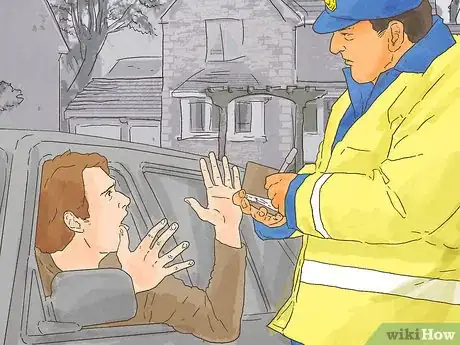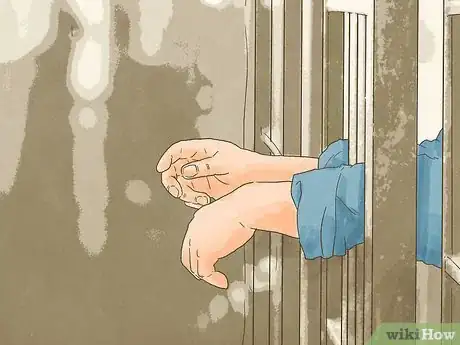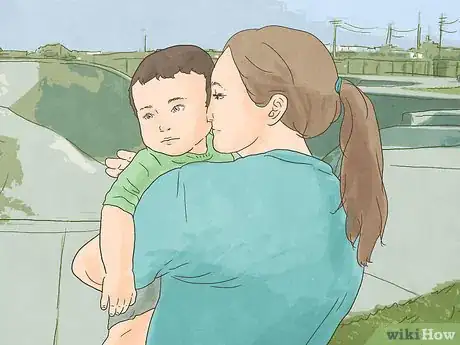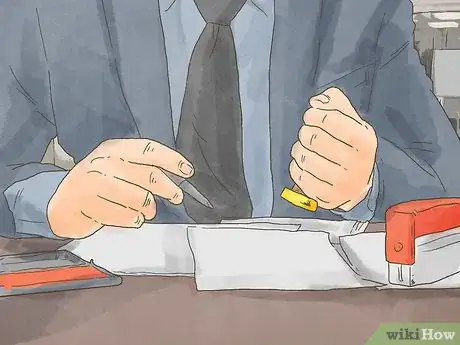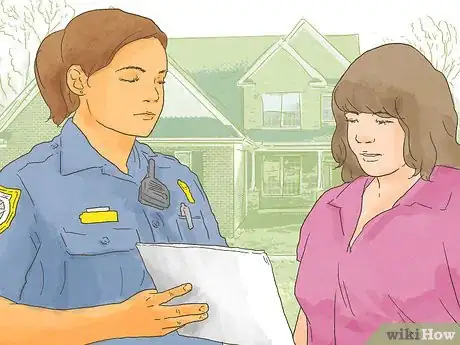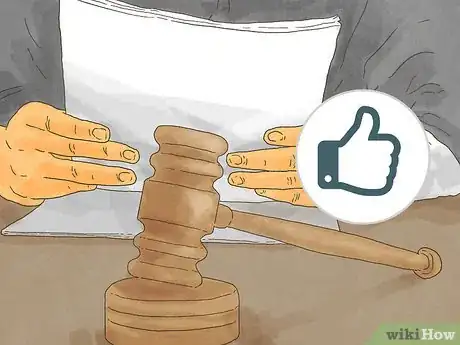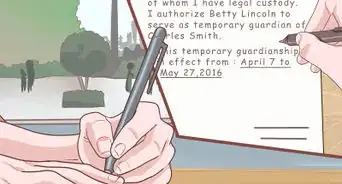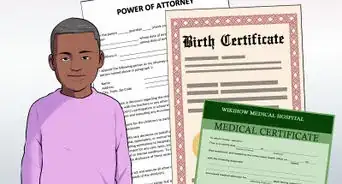This article was co-authored by Clinton M. Sandvick, JD, PhD. Clinton M. Sandvick worked as a civil litigator in California for over 7 years. He received his JD from the University of Wisconsin-Madison in 1998 and his PhD in American History from the University of Oregon in 2013.
There are 13 references cited in this article, which can be found at the bottom of the page.
This article has been viewed 30,777 times.
You can get child custody if you have a felony record, though it will be difficult.[1] Ultimately, a judge makes custody determinations on the basis of what is in the child’s best interests, and your criminal record will definitely be something the judge considers. If you want custody, you should first analyze how serious the felony conviction will look to a judge. You should also meet with a lawyer to discuss strategies for making your strongest case possible. When you are ready to apply for custody, you should file the correct forms with the court and send the other parent a copy.
Steps
Analyzing Your Situation
-
1Get your criminal history reports. You need to thoroughly go through your criminal history and analyze every felony, not just the most recent one. You should get a complete criminal history. Generally, you can get your criminal history by contacting the Federal Bureau of Investigations (FBI) or an agency in each state where you were convicted of a crime.
- Information for the FBI is available here: https://www.fbi.gov/services/cjis/identity-history-summary-checks.
- See Review Your Criminal Record for more information.
-
2Identify convictions for violent felonies. It matters whether your felony was for a violent crime or not. In particular, if you were convicted of a violent offense, then the judge might wonder whether you can control your anger.[2] The following are violent crimes:[3]
- Assault and battery
- Murder
- Domestic violence
- Child abuse (whether emotional, physical, or sexual)
- Harassment, such as stalking or cyberstalking
- Kidnapping
- Sex crimes
- Robbery
Advertisement -
3Consider who was the victim of your violent crime. It also matters who was the victim. If you committed a violent crime against any of your children, then you can expect the judge to try and limit your contact with them.[4]
- You probably will not get full custody and may only have limited visitation, which will also probably be supervised.
- If you sexually abused one of your children, then the judge could also terminate your parental rights totally.
-
4Analyze whether the crime was non-violent. You have a better chance of getting child custody if your felony conviction was for a non-violent crime. For example, the following generally qualify as non-violent:[5]
- Fraud or embezzlement
- Tax crimes
- Bribery
- Gambling
-
5Identify crimes involving substance abuse. Although drug crimes are not violent, a judge will look on them negatively as well, since they suggest you have problems with drugs or alcohol. Go through your criminal record and identify any drug offenses.
- Also look for a DUI or other alcohol-related offense.
- If you have a drug conviction, then you can expect that the judge will want you to take a drug test.
- You may also only get supervised visitation with a drug offense.[6]
-
6Consider the age of the conviction. The older your conviction for a felony, the better.[7] For example, if you have a drug or DUI conviction that is 20 years old, then you can argue that it was an isolated incident that doesn’t reflect your current character.
- There is no precise cut-off where a conviction becomes meaningless for purposes of child custody. Instead, think of it as a sliding scale. The further back in time, the better.
- It also matters whether you were a repeat offender. For example, you might have a DUI that is 15 years old. However, if you got a second DUI this year, then the judge probably won’t discount the older DUI. Instead, it looks like you have a continuing problem with alcohol.
-
7Check the length of your sentences. The judge also looks at length of sentences because that can impact your ability to provide a stable home for your child. If you have a history of long or multiple jail sentences, then you don’t look like a good risk in the judge’s eyes.[8]
-
8Meet with a lawyer. Only a qualified lawyer can analyze your situation and tell you how a judge will look at your felony convictions. When you get the name of a lawyer, schedule a consultation and take paperwork that shows your entire criminal history.
- You can get a referral to a family law attorney by contacting your local or state bar association.
- Call up the lawyer and ask how much the consultation will cost.
-
9Come up with a strategy for explaining your criminal history. Your lawyer can talk with you about different ways you can minimize your criminal history when you apply for child custody. For example, you might use the following strategies:
- Show you have reformed. If you have an isolated violent felony in the past, you can show evidence that you have turned your life around. For example, you can point out that you have completed drug or alcohol treatment or an anger management course. Stable employment and community service is also helpful.
- Argue the other parent is worse. Look to find felony convictions or other bad behavior in the other parent’s background. Also find out if the other parent’s new boyfriend or girlfriend (or spouse) has a criminal history.
-
10Identify how living with you is in the child’s best interests. To get custody, you must always show that custody is in the child’s best interest. Talk with your lawyer about what this means. Your criminal history is part of the “best interests” analysis. However, the judge also considers many other factors, such as the following:[9]
- Each parent’s mental and physical health.
- Your child’s need for a stable home environment, as well as continuity in schooling.
- The age and sex of your child.
- What your child wants (if old enough to make an informed choice).
- How much each parent supports your child’s relationship with others, such as grandparents, members of the extended family, and the other parent.
- Excessive discipline or emotional abuse.
- If your child has special needs, who can take care of them.
Filing for Child Custody
-
1Gather required forms from the court clerk. Most courts should have printed, “fill in the blank” forms you can use for requesting custody. Go to the court in the county where the child lives and tell the clerk you want to file for custody.[10] There are different forms depending on the situation:
- You are getting divorced. You will make a request for custody as part of your divorce petition.
- You are trying to establish paternity. You might never have been married to the child’s mother. In this situation, you might need to establish paternity and seek child custody at the same time.
- You are unmarried but have already acknowledged paternity.
- You are trying to modify custody. The other parent might already have gotten custody. In this case, you will need to fill out different forms and explain why there has been a substantial change in the current situation that warrants changing custody.[11]
-
2Complete the forms. Fill them out neatly. If you downloaded the forms in PDF format, then you should be able to enter the information directly into the form. If you print, then print neatly using black ink.
- Provide all requested information. If a question or item doesn’t apply to you, then write “N/A” or “not applicable.”
- You must sign your forms. In some states, your signature must be notarized. Find a notary public and sign in front of them.
-
3File the forms. Make several copies of the completed forms and take them, along with the original, to the court clerk. Ask the clerk to file. The clerk can stamp your copies with the filing date. Always remember to keep one copy of any document you file with the court.
- You might have to pay a filing fee.[12] The amount will vary depending on the court. If you can’t afford the fee, then ask the clerk for a fee waiver form and fill it out.
-
4Serve the forms on the other parent. The other parent gets a chance to respond to your petition for child custody, so you need to arrange to send the forms to him or her. Make a copy of everything you filed and get a “summons” from the court clerk.[13] Unfortunately, you can’t serve the papers yourself.
- Instead, you can usually pay the sheriff or constable to make hand delivery.
- There may be other acceptable methods, such as mailing them certified mail, return receipt requested. Check with the court clerk.
-
5Read the other parent’s response. The other parent probably will respond in writing, opposing your petition for child custody. The parent should send you a copy of whatever document they file. Read it closely.
-
6Participate in mediation. Some courts have a policy of trying to get parents to resolve custody issues through mediation. In mediation, both parents meet with a neutral third party, the mediator.[14] The mediator’s job is to get each side to talk to each other in the hopes of reaching a compromise. The mediator is not a judge and won’t decide anything.
- The judge might order you to go to mediation, or you could also ask if a court mediation program is available.
- You also have the option of going to mediation yourself even if it isn’t court-ordered. You can find mediators by contacting your nearest courthouse or getting a referral from your state’s bar association.
- When mediation is successful, you sign your custody agreement and present it to the judge for approval.
Undergoing a Custody Evaluation
-
1Meet for a custody evaluation. Where mediation fails, the judge might order a custody evaluation. It is usually done by a court-appointed social worker who has been trained in family law issues. However, in some courts, you might be able to hire your own evaluator.
- The evaluator will want to interview you, and will also probably want to evaluate how well you interact with the child. The purpose of the meeting is to allow the evaluator to observe your fitness as a parent.
- Generally, both parents will split the cost of the evaluation, though the court might also pay for the evaluation in some cases.[15]
-
2Answer the evaluator’s questions. Be prepared to talk in detail about your relationship with the child. For example, the evaluator might ask questions like “Please describe your relationship with the child” and “Describe the child’s relationship with the other parent.”[16]
- You should also be prepared to talk about your felony conviction. Be honest. You don’t want to tell one story to the evaluator and then a different story in court.
-
3Undergo psychological testing. As part of the custody evaluation, you may also have to undergo psychological testing. The purpose of the testing is to uncover any behavioral traits that might impact your ability to parent. For example, the tests might try to uncover any of the following:[17]
- Major disorders like bipolar disorder or psychosis
- Substance abuse or dependency
- Impulse control and problems with judgment
- Dangerous, whether to others or to yourself
- History of trauma
- Impaired function as a result of stroke, illness, or disease
-
4Read the evaluator’s report. After meeting with everyone, the evaluator should prepare a report for the judge. The report should summarize the evaluator’s findings and make a recommendation about custody.[18] You may be able to get a copy. You should read it closely and be prepared to address anything you don’t agree with.
- Also pay attention to what the evaluator said, if anything, about your criminal history or your psychological testing.
- For example, if the testing showed no substance dependency, then that is strong evidence in your favor if your felony conviction was for a drug crime.
Going to Court
-
1Hire a lawyer if the other parent has one. You might have met with a lawyer just to talk about your case. However, if you can’t resolve the dispute in mediation with the other parent, then you should think about hiring a lawyer to represent you at trial. Trials are complicated, and your situation is even more complicated because you have a felony conviction. You will be at a disadvantage if the other parent has a lawyer but you don’t.
- Talk to the lawyer about how much it would cost to have them represent you at trial. Many lawyers charge by the hour, but some might be willing to charge a flat fee.
- See Minimize Attorney Fees if money is a concern.
-
2Gather helpful documents. You need evidence at trial. Your testimony is certainly some evidence. However, judges also trust documents because they assume that you will testify in a way that is favorable to your position. Try to find the following helpful documents:
- If the other parent has abused or neglected the child, then get medical records or copies of police reports.
- If the other parent lives with someone who has a criminal history, then get copies of their criminal record.
- You can show that you have reformed by bringing in evidence of a solid work history or successful completion of a drug treatment program.
-
3Find helpful witnesses. You can also have witnesses testify. They might be able to testify that they have observed you and the child together. They may also testify that the other parent isn’t fit to have custody. The following make good witnesses:
- Teachers or child care workers who have seen you with the child and who have seen the other parent with the child.
- Members in the community who have observed you with your child.
- Boss or employer, who can testify that you are a stable individual.
- The other parent’s family members. For example, if you can get the other parent’s sibling to testify against them, then you have an excellent witness.
-
4Dress appropriately. You want to look professional for the judge, who is trying to analyze your character. Because you have a felony on your record, you want to be extra-careful to appear professional. You should dress conservatively in clean, well-pressed clothes.
- See Dress for a Court Hearing for more information.
-
5Testify on your own behalf. You probably also have to testify. You can expect the other parent to make a big deal about your criminal history, so be prepared for uncomfortable questioning. Your lawyer can help soften the blow by asking about it first. When cross-examined, remember the following tips:
- Speak clearly and loudly so that everyone in the courtroom can hear you.
- Don’t guess. Instead, say “I don’t know” if you don’t know the answer.
- Always tell the truth. If you lie on the stand, then you will hurt your credibility.
- Avoid sarcasm or displays of anger. Instead, take a deep breath if you feel angry.
-
6Cross-examine the other parent’s witnesses. The other parent gets to present witnesses and documentary evidence as well. Your lawyer should have a chance to cross-examine those witnesses.
- If you are representing yourself, then read Question Witnesses when Representing Yourself for helpful guidance.
-
7Receive the judge’s decision. After all evidence has been submitted, the judge should make a decision about child custody and issue an order.[19] Always remember to stay polite and respectful of the judge, even if you lose.
- You should talk to a lawyer about bringing an appeal if you are unhappy with the decision. You can only appeal if you think the judge made a serious error.
References
- ↑ https://www.utahcriminallaw.net/can-still-get-child-custody-criminal-record-utah/
- ↑ https://www.freeadvice.com/legal/criminal-convictions-impact-on-child-custody-cases/
- ↑ http://www.legalmatch.com/law-library/article/non-violent-vs-violent-crimes.html
- ↑ https://www.freeadvice.com/legal/criminal-convictions-impact-on-child-custody-cases/
- ↑ http://www.legalmatch.com/law-library/article/non-violent-vs-violent-crimes.html
- ↑ https://www.freeadvice.com/legal/criminal-convictions-impact-on-child-custody-cases/
- ↑ https://www.freeadvice.com/legal/criminal-convictions-impact-on-child-custody-cases/
- ↑ https://www.freeadvice.com/legal/criminal-convictions-impact-on-child-custody-cases/
- ↑ http://family.findlaw.com/child-custody/focusing-on-the-best-interests-of-the-child.html
- ↑ https://www.nycourts.gov/courthelp/family/custodyFiling.shtml
- ↑ http://www.indianalegalservices.org/node/28/modifying-child-custody
- ↑ http://www.mass.gov/courts/selfhelp/family/child-custody-forms.html
- ↑ https://www.nycourts.gov/courthelp/family/custodyFiling.shtml
- ↑ http://courts.mi.gov/administration/scao/resources/documents/publications/manuals/focb/custodyguideline.pdf
- ↑ http://www.courts.ca.gov/documents/fl329info.pdf
- ↑ http://courts.mi.gov/administration/scao/resources/documents/publications/manuals/focb/custodyguideline.pdf
- ↑ https://www.hg.org/article.asp?id=18058
- ↑ http://courts.mi.gov/administration/scao/resources/documents/publications/manuals/focb/custodyguideline.pdf
- ↑ https://www.nycourts.gov/courthelp/family/custodyHearing.shtml




